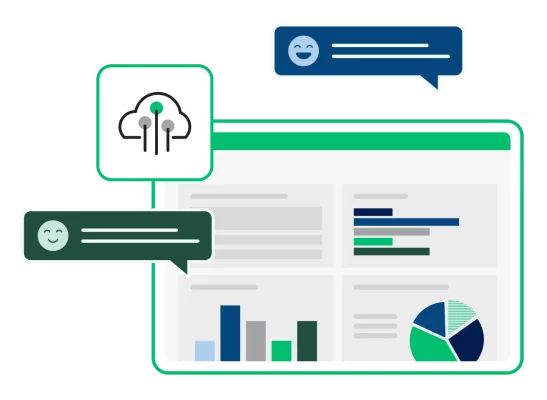What is thematic analysis?
Learn how to use thematic analysis to identify, analyze and report patterns with your data to uncover deeper insights and create successful strategies.

- Thematic analysis is a method of qualitative data analysis that identifies patterns or themes within data to interpret and understand underlying meanings or concepts.
- Researchers using inductive thematic analysis remain open to new ideas and insights. Deductive thematic analysis entails researchers engage data with a hypothesis.
- You should use thematic analysis when you want to identify patterns and themes, understand participant perspectives, and complement your quantitative research.
Ever find yourself swimming in a sea of qualitative data, wondering where to even begin? That's where thematic analysis jumps in like a trusty life raft. It's like detective work for researchers, helping them uncover hidden gems and insights within all that text or imagery.
Thematic analysis is a qualitative research method for identifying, analyzing, and interpreting patterns and themes within a dataset. It isn't just about skimming the surface; it's about diving deep into the heart of qualitative data.
Thematic analysis can be applied in various contexts. It's widely used in qualitative studies to understand participants' perspectives and analyze written, visual, or audio content, such as interviews, documents, images, or videos. Thematic analysis can also help businesses understand consumer opinions and attitudes by analyzing customer feedback, reviews, or social media content.
What is thematic analysis?
Thematic analysis is a qualitative method of data analysis that involves identifying, analyzing, and reporting patterns in data to find themes. It's a common method used to analyze text, video, and audio data.
This method is not a linear process but rather a dynamic journey, where researchers continuously refine their understanding through iterations. Through embracing this flexibility, thematic analysis empowers researchers to delve deeper into the diverse perspectives and lived experiences of research participants, enriching their understanding of the participants’ stories.
Thematic analysis helps researchers extract meaningful insights from qualitative data. It provides a structured framework for organizing and synthesizing large volumes of qualitative data. It makes data more manageable and accessible for analysis. The insights gained from thematic analysis can inform decision-making processes in various aspects of business.

The goal of thematic analysis is to identify themes or patterns in the data that are important or interesting, and use these themes to address the research or say something about an issue. Thematic analysis is beneficial when you're working with large bodies of data, such as open-ended survey responses, app review comments, or social media posts. It is particularly useful when you're looking for subjective information such as experiences and opinions.
For example, you may want to conduct thematic analysis to understand the interviews you did regarding how customers like or dislike the new product. Another example is that you can use thematic analysis to gather insights into what will affect employees’ motivation and productivity at work within your organization.
How does thematic analysis compare to other analysis methods?
Thematic analysis is great for uncovering underlying meanings and concepts. It's more suitable for exploratory and interpretive research. Thematic analysis prioritizes the voices and perspectives of participants. It is best for listening to your customers and audiences.
Other qualitative analysis, such as content and narrative analysis, focuses on the content itself. It's more suitable for descriptive research. Content analysis is better for quantitative assessment and categorization of the data. Narrative analysis emphasizes understanding how individuals construct their storytelling.
Let’s use one example to understand the differences. Suppose you would like to understand customer feedback on your product, and you collected all product reviews online. Thematic analysis can help you identify recurring themes, patterns, and sentiments in the reviews. It answers questions like “Do customers most like or dislike it?” “What do customers like about it?”
Content analysis of the same material will quantify the elements of the data. You might code for the frequency of keywords related to different features of the product (e.g., "easy to set up," "durability") and the overall rating given by customers (e.g., number of stars). You can then summarize and visualize the quantified data to show the whole picture of customer reviews.
Narrative analysis would examine the structure and emotional tone of individual stories shared by customers. It’s more about how each individual tells and constructs the story.
Thematic analysis is a versatile method that can be applied to various types of data sources. It is particularly well-suited for analyzing interview data, whether from individual interviews or focus groups. Thematic analysis can analyze open-ended survey responses, where participants provide qualitative feedback in their own words. Another type of data it can handle well is textual data, such as written documents, social media posts, online forums, or news articles.
Related Article: Qualitative vs. quantitative research: What’s the difference?
When should I use thematic analysis?
Here are some instances where you may use thematic analysis:
- Exploratory research: Thematic analysis is ideal for uncovering new insights and understandings about a topic or phenomenon. It allows researchers to dive into qualitative data without assumptions, facilitating discovery and exploration.
- Identifying patterns and themes: Researchers can uncover underlying trends and themes. It provides a deeper understanding of the research topic.
- Understanding participant perspectives: Thematic analysis helps researchers understand participants' perspectives, experiences, and viewpoints.
- Complementing quantitative research: Thematic analysis provides qualitative context and depth to numerical data. It helps researchers understand the "why" behind quantitative findings.
Inductive vs. deductive thematic approach
Inductive and deductive thematic approaches represent two distinct paths in qualitative research, each with its own set of strengths and implications.
Inductive thematic approach
Inductive thematic analysis starts with raw data and allows themes and patterns to emerge organically through the process of coding and analysis. It's a bottom-up approach. Researchers remain open to new ideas and insights as they engage deeply with the data.
The inductive approach offers flexibility to adapt to the nuances and complexities of the data. It allows for the discovery of unexpected themes and insights. By starting with the data itself, inductive analysis can provide a rich understanding of participants' experiences and perspectives. However, the iterative nature of inductive analysis can be time-consuming. It requires careful and thorough engagement with the data.
For example, you may want to understand how consumers perceive sustainable packaging in the food industry. You conducted interviews with consumers. Through the inductive thematic analysis, you immerse yourself in the interview transcripts and code the data without predefined categories.
With this approach, themes may emerge from the transcript. You may conclude that "Environmental Concerns," "Perceived Benefits of Sustainable Packaging," and "Barriers to Adoption" are the common themes about sustainable packaging. You may also uncover insights you did not expect to find, such as consumers' motivations for choosing sustainable packaging options and the challenges they face in understanding such products.
Deductive thematic approach
By contrast, deductive thematic analysis begins with a predefined set of codes or themes derived from existing frameworks or research questions. It's a top-down approach. Researchers start with a hypothesis or framework and seek to confirm or refute it through the analysis of data.
Deductive thematic analysis allows researchers to test hypotheses. By starting with predefined codes or themes, deductive analysis can be more efficient than inductive analysis, particularly when the research question is well-defined. However, there's a risk of bias in deductive analysis. Researchers may overlook or misinterpret data that doesn't fit neatly within the predefined framework.
Let’s say you want to know how brand loyalty influences consumer purchasing behavior of mobile phones. You may look into existing market research and hypothesize that brand loyalty can promote mobile phone purchases. You use the deductive approach and analyze online reviews and social media comments. You will specifically look for textual mentions and descriptions of brand loyalty and purchasing behavior.
The analysis then confirms the influence of brand loyalty on purchasing behavior, with themes emerging around "Brand Reputation," "Perceived Value," and "Customer Loyalty Programs."
How to conduct thematic analysis

Let's walk through a step-by-step thematic analysis guide.
1. Familiarize yourself with the dataset
Before diving into analysis, familiarize yourself with the data by reading through it multiple times. This helps you gain a comprehensive understanding of the content and context.
Imagine you're conducting a study on customer feedback regarding a new online shopping platform. Take time to read through customer reviews, comments, and feedback forms to familiarize yourself with the range of opinions and experiences expressed by users.
2. Generate initial codes
Start by systematically coding the data. Label segments of text that represent meaningful themes or patterns. Begin with open coding. Allow codes to emerge organically from the data.
As you read through customer feedback, you might start coding phrases like "user-friendly interface," "fast delivery," "poor customer service," or "wide product selection" to capture different aspects of the online shopping experience.
3. Search for themes
Once you've generated initial codes, look for patterns and connections among them to identify potential themes or overarching concepts. Group related codes together to form preliminary themes.
You notice that several codes relate to the website's usability, delivery speed, and customer service quality. These codes could be grouped under a broader theme of "User Experience."
4. Review and revise themes
Review the identified themes and their corresponding codes. Ensure they accurately reflect the data. Refine or combine themes as needed to create a coherent and comprehensive thematic framework.
Upon review, you find that some codes related to customer service could fit under the broader theme of "Customer Support" alongside other codes related to return policies and inquiries.
5. Define themes
Define each theme by clearly articulating its underlying concept or idea. Provide descriptive names for each theme that succinctly capture its essence.
You define the theme of "User Experience" to encompass feedback related to website navigation, product search functionality, and overall satisfaction with the platform's usability.
6. Write the report
Document and report your findings. Organize them according to the identified themes. Provide illustrative quotes or examples from the data to support each theme and offer deeper insights.
In your research report, you present findings under thematic headings such as "User Experience," "Product Quality," and "Customer Support". Then provide quotes from customers to highlight key points within each theme.
Challenges of thematic analysis
Thematic analysis, while a valuable qualitative research method, comes with its own set of challenges.
Interpretation of data in thematic analysis can be subjective, as researchers may bring their own biases or perspectives to the analysis process. This subjectivity can influence the identification and interpretation of themes. Therefore, inconsistent or biased findings may arise.
Developing meaningful and relevant codes that accurately capture the data can be challenging. Researchers must strike a balance between creating codes that are too specific and too broad. Overly specific coding can lead to fragmentation of the data. Being too broad, on the other hand, may overlook important nuances within the data.
Additionally, thematic analysis often involves analyzing large volumes of qualitative data, which can be overwhelming and time-consuming. Researchers may struggle to manage and analyze the sheer volume of data. They may experience fatigue or burnout during the analysis process.
Communicating the findings of thematic analysis in a clear and meaningful manner can be challenging too. Researchers must navigate the tension between providing rich data and maintaining brevity in their reporting. Ensuring that the findings are not overgeneralized requires careful attention to detail and reflexivity.
Thematic analysis best practices
- Clear research question: Start with a well-defined research question or objective that guides the thematic analysis process. This ensures that the analysis remains focused and relevant to the research goals.
- Data management: Organize and manage your qualitative data effectively to facilitate analysis. This may involve transcribing interviews, labeling data sources, and storing data in a systematic manner to ensure easy access and retrieval during analysis.
- Coding consistency: Establish clear coding guidelines and criteria to ensure coding is consistent across coders, if applicable.
- Reflexivity: Maintain reflexivity throughout the analysis process by critically reflecting on your own assumptions and biases. Consider how your background and perspectives may influence the analysis and interpretation of the data.
- Iterative process: Thematic analysis is often iterative, with multiple cycles of coding, reviewing, and refining themes. Embrace this iterative nature and be open to revisiting and revising your analysis as new insights emerge from the data.
Conduct your thematic analysis with SurveyMonkey
SurveyMonkey can facilitate thematic analysis in your market research. SurveyMonkey can be used to collect qualitative data through open-ended survey questions. They allow researchers to gather textual responses from participants.
SurveyMonkey offers a few tools to analyze open-ended questions. Sentiment Analysis uses machine learning and natural language processing (NLP) to categorize responses as positive, neutral, or negative. Word Cloud counts frequently used words in text responses and presents them visually. You can also tag your responses to uncover more specific information. You can assign multiple tags to the same response.
SurveyMonkey provides tools for organizing and managing qualitative data collected through surveys. Researchers can export textual responses from SurveyMonkey in formats compatible with qualitative analysis software such as NVivo, MAXQDA, or Dedoose or manual coding processes.